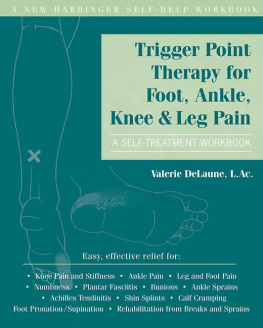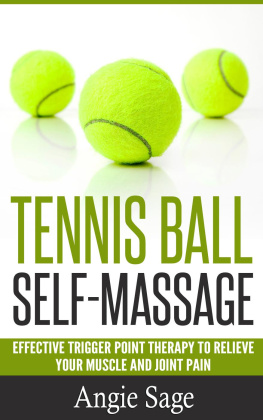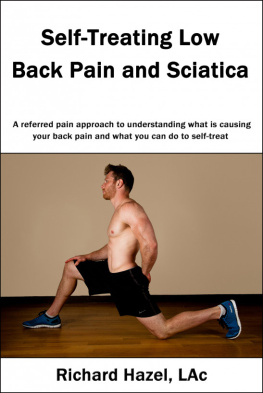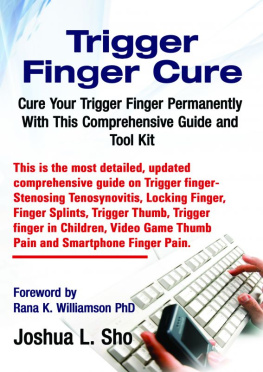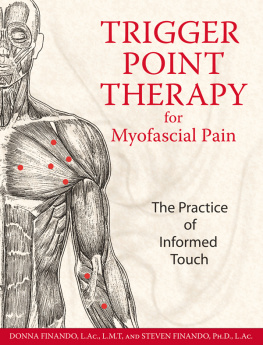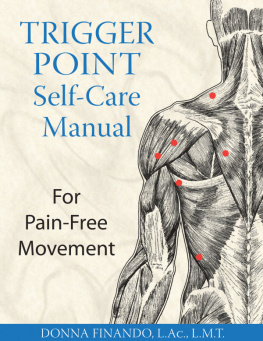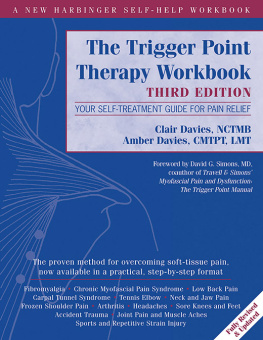References
Audette, J. F., F. Wang, and H. Smith. 2004. Bilateral activation of motor unit potentials with unilateral needle stimulation of active myofascial trigger points. American Journal of Physical Medicine and Rehabilitation83(5):36874.
Balch, J. F., and P. A. Balch. 2000. Prescription for Nutritional Healing: A Practical AZ Reference to Drug-Free Remedies Using Vitamins, Minerals, Herbs, and Food Supplements. New York: Avery.
Borg-Stein, J., and D. G. Simons. 2002. Myofascial pain. Archives of Physical Medicine and Rehabilitation 83(Suppl 1):S4047.
Chen Q., S. Bensamoun, J. R. Basford, J. M. Thompson, and K. N. An.2007.Identification of myofascial taut bands with magnetic resonance elastography.Archives of Physical Medicine and Rehabilitation 88:16581661.
Edwards, J., and N. Knowles. 2003. Superficial dry needling and active stretching in the treatment of myofascial pain: A randomised controlled trial. Acupuncture in Medicine 21(3):8086.
Hinkers, M. 2009. Diabetes: Taking steps to prevent amputation. Lower Extremity Review1(2):3340.
Issbener, U., P. Reeh, and K. Steen. 1996. Pain due to tissue acidosis: A mechanism for inflammatory and ischemic myalgia? Neuroscience Letters208 (1996):191194.
Kuan, T. 2009. Current studies on myofascial pain syndrome. Current Pain and Headache Reports13:365369.
Latremoliere, A., and C. J. Woolf. 2009. Central sensitization: A generator of pain hypersensitivity by central neural plasticity. The Journal of Pain10(9):895926.
Li, J. , and C. Muehleman. 2007. Anatomic relationship of heel spur to surrounding soft tissues: Greater variability than previously reported.Clinical Anatomy20:950955.
Marcus, D. A., L. Scharff, S. Mercer, and D. C. Turk. 1999. Musculoskeletal abnormalities in chronic headache: A controlled comparison of headache diagnostic groups. Headache: The Journal of Head and Face Pain 39(1):2127.
Murphy, L., T. Z. Schwartz, C. G. Helmick, J. B. Renner, G. Tudor, G. Koch, A. Dragomir, W. D. Kalsbeek, G. Luta, and J. M. Jordan. 2008. Lifetime risk of symptomatic knee osteoarthritis. Arthritis and Rheumatism59(9):12071213.
Niddam, D. M. 2009. Brain manifestation and modulation of pain from myofascial trigger points. Current Pain and Headache Reports13:370375.
Partanen, J., T. A. Ojala, and J. P. A. Arokoski. 2009. Myofascial syndrome and pain: A neurophysiologic approach. Pathophysiology, doi:10.10266/j.pathophus.2009.05.001.
Shah, J. P., J. V. Danoff, M. J. Desai, S. Parikh, L. Y. Nakamura, T. M. Phillips, and L. H. Gerber. 2008. Biochemicals associated with pain and inflammation are elevated in sites near to and remote from active myofascial trigger points. Archives of Physical Medicine and Rehabilitation89:1623.
Simons, D. G. 2003. Enigmatic trigger points often cause enigmatic musculoskeletal pain. Presentation at the STAR Symposium, Columbus, Ohio, May 22. Available at http://ergonomics.osu.edu/ pdfs/2003%20STAR%20Symposium/Simons%20Trigger.pdf.
. 2004. Review of enigmatic MTrPs as a common cause of enigmatic musculoskeletal pain and dysfunction. Journal of Electromyography and Kinesiology 14(1):95107.
Simons, D. G., J. G. Travell, and L. S. Simons. 1999. Myofascial Pain and Dysfunction: The Trigger Point Manual. Vol. 1, The Upper Extremities, 2nd ed. Baltimore, MD: Lippincott Williams & Wilkins.
Travell, J. G., and D. G. Simons. 1983. Myofascial Pain and Dysfunction: The Trigger Point Manual. Baltimore, MD: Lippincott Williams & Wilkins.
. 1992. Myofascial Pain and Dysfunction: The Trigger Point Manual. Vol. 2, The Lower Extremities.Baltimore, MD: Lippincott Williams & Wilkins.
Wickstrom, E., and M. Cordova. 2009. Ankle balance training targets recurrent injury. Lower Extremity Review 1(3):5154.
Valerie DeLaune clearly explains, in simple, non-clinical terms, what every person should know about conservative self-treatment and the prevention of lower extremity pain. Although the author points out that trigger point therapy is often classified as alternative medicine, these proven techniques are supported by current research and based on many years of effective clinical experience. The beauty of trigger point therapy is that the average person can quickly learn the self-care techniques and incorporate them into a daily routine, measuring their own success by their steady and sometimes drastic reduction of pain and their ability to return to normal activities. If myofascial trigger points are the source of your lower extremity pain, then you will find this basic book to be a critical tool in your journey to self-healing.
Renee Gladieux Principe, NCTMB, massage therapist and vice president of sales for the Pressure Positive Company
There are few self-help books I can routinely recommend because most of them either dumb it down, or demand too much prior knowledge. This book is a sterling exception. I have been using trigger point therapy routinely for well over thirty years, and there was new material that rocked my boat. At the same time, the uninitiated can benefit from this book. DeLaune has synthesized a wonderful book that works as a standalone breakdown of trigger point therapy of the lower extremities or as part of her series. Any time people increase their knowledge of how to care for their bodies and start taking more responsibility, they achieve a greater level of control. This translates into a higher quality of life. Read, enjoy, and, most of all, apply!
Steven Lavitan, DC, chiropractor, licensed acupuncturist, and nutritionist

Publishers Note
This publication is designed to provide accurate and authoritative information in regard to the subject matter covered. It is sold with the understanding that the publisher is not engaged in rendering psychological, financial, legal, or other professional services. If expert assistance or counseling is needed, the services of a competent professional should be sought.
Distributed in Canada by Raincoast Books
Copyright 2010 by Valerie DeLaune
New Harbinger Publications, Inc.
5674 Shattuck Avenue
Oakland, CA 94609
www.newharbinger.com
Cover design by Amy Shoup
Text design by Michele Waters-Kermes
Acquired by Jess OBrien
Edited by Jean M. Blomquist
All Rights Reserved
Epub ISBN: 978-1-60882-239-3
The Library of Congress has cataloged the print edition as:
DeLaune, Valerie.
Trigger point therapy for foot, ankle, knee, and leg pain : a self-treatment workbook / Valerie DeLaune.
p. cm.
Includes bibliographical references and index.
ISBN 978-1-60882-239-3
1. Foot--Diseases--Chiropractic treatment--Handbooks, manuals, etc. 2. Ankle--Diseases--Chiropractic treatment--Handbooks, manuals, etc. 3. Knee--Diseases--Chiropractic treatment--Handbooks, manuals, etc. 4. Leg--Diseases--Chiropractic treatment--Handbooks, manuals, etc. 5. Pain--Alternative treatment--Handbooks, manuals, etc. 6. Self-care, Health--Handbooks, manuals, etc. I. Title.
RZ265.F66D45 2010
617.585--dc22
2010020701
Contents
Acknowledgments
Approximately 38 percent of the human population is in pain at any given time. Although 30 percent of patients seen in a general physicians practice are there due to pain caused by trigger points (Simons 2003), there is still very little emphasis in medical school on muscle pain and trigger points. Thankfully, a few pioneers have worked endlessly to research trigger points, document referral patterns and other symptoms, and bring all of that information to medical practitioners and the general public.

